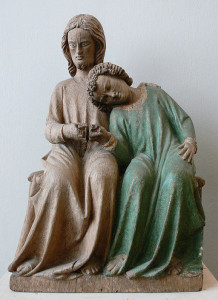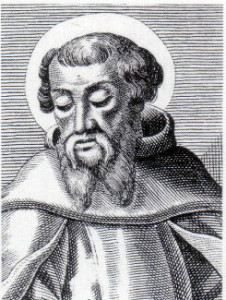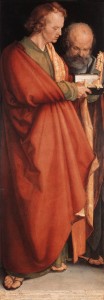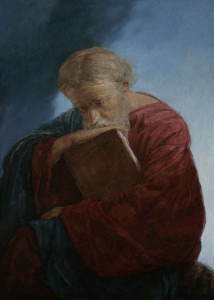Of all the gospel accounts, the Gospel According to John is the most controversial. It stands apart from the three “synoptic” gospels of Matthew, Mark, and Luke. John is more sophisticated theologically and contains some of the most beautifully-written verses in the New Testament. It was, according to Christian tradition, written by the Apostle, John. John was one of Jesus’ 12 original disciples, and is referred to as the “Beloved Disciple” of Christ. This work is important not only because of its theological insights, but also because it supposedly reflects an eyewitness account of Jesus’ ministry and teachings.
The book is more focused on detailing the crucial theological underpinnings of Christianity than on sharing an orderly historical narrative. Because of these and other reasons, many critics question the origin and reliability of John’s gospel.
In a 2013 article promoting his book, The Fourth Gospel: Tales of a Jewish Mystic, the controversial bishop, John Shelby Spong, articulates the “anti-John” position when he asserts (among other things) that
- The Gospel According to John could not have been written by the so-called “Beloved Disciple” of Jesus: John, son of Zebedee. Instead, it was written by several people over a long time period, and therefore could not be an eyewitness account of Jesus’ ministry.
- The book is not historically reliable and was never intended by its authors to be read as an accurate history.
Spong claims that his low opinion of John’s gospel is the result of an in-depth 5-year study, which he relates in his book. Other scholars, such as Bart Ehrman, share some of Spong’s views on the topic.
When objectively reviewing the evidence, however, the case against John is not nearly as clear-cut as Spong would have his readers believe. In fact, there are strong arguments that John actually did write (or provide direct testimony for) the book that bears his name. That would make it an eyewitness account after all. In addition, there is growing evidence that the book is historically reliable, and was intended to be read as a historically accurate theological work.
Those making blanket negative statements about John, one of the most important books in the Bible, are not doing so objectively. Multi-volume sets have been written about this gospel, and there is no way a single article can cover all the bases. However, we’ll hit some of the key points as we mount a defense of this critical book.
Who Wrote John and When?
The External Evidence and Testimony
Most scholars, both secular and evangelical, date the writing of John to about 85-95 A.D. Some have proposed a much later date, but they are definitely on the fringes of scholarly opinion. If the Apostle John was the true author, then he would have been a very old man, likely 80-90 years old. John’s birth was thought to be in about 6 A.D. and he died around 100 A.D. Church tradition holds that John did write his gospel as an old man in Ephesus.
A long chain of writings—external to the Bible—by church historians and early church fathers assert that the Apostle John was the author of the gospel. It was not a topic of dispute, and seems quite well attested. This known chain of testimony regarding John’s authorship goes nearly back to John himself.
Starting with the most recent and working back to the earliest, here is a partial list of ancient works that affirm John’s authorship:
- Eusebius (c.265-340) in his Ecclesiastical History (Chapter 24) clearly identifies John the Apostle as the author of the fourth gospel.
- Origen (c.185-254) in his Commentary on Matthew, mentions John as the last gospel written. In his commentary on John, he describes its special importance. Origen is also quoted by Eusebius in his Ecclesiastical History as having written that he had learned through tradition that John was the author.
- Tertullian (160-225) refers to John’s authorship in Against Marcion (4.5).
- Clement of Alexandria (c.150-215), as related in Eusebius’ Ecclesiastical History (6.14.7) states: “But last of all, John, perceiving that the external facts had been made plain in the Gospel, being urged by his friends, and inspired by the Spirit, composed a spiritual Gospel.” This testimony, dating to within 50 years of John’s death, explains its authorship and expresses why John’s gospel is so different from the other gospels.
- Irenaeus (c. 130-200) in Against Heresies (3.1.1), confirms John as the author. Irenaeus frequently quotes from John, treating it as a widely used and highly respected book in the church. It’s important to note that Irenaeus was a follower of Polycarp (80-167), who was a disciple of John himself. Irenaeus was in an excellent position to know the truth of John’s authorship, due to his relationship with Poycarp.
It’s also interesting to note that an ancient preface to the Gospel of John, known as the Anti-Marcionite Prologue and written c. 350 A.D., says, “The Gospel of John was revealed and given to the churches by John while still in the body, just as Papias of Hieropolis, the close disciple of John, related in the exoterics, that is, in the last five books. Indeed he wrote down the gospel, while John was dictating carefully…” (Emphasis added).
Not much is known of Papias, but he was the Bishop of Hierapolis, a colleague of Polycarp, and someone who seems to have known the Apostle John directly. It’s very interesting that Papias attested to John’s authorship, because you can’t get much closer than that to the actual author.
Also, the Prologue’s mention that Papias penned the gospel while John dictated is interesting. Given John’s advanced age at the time, it’s not surprising that he may have used scribes to help complete the book.
Some scholars have written that the use of scribes or secretaries to help write such works was not uncommon, and that more than one could have assisted John. This would explain some scholars’ impression that the book was the work of several authors. Indeed, the gospel itself seems to disclose this in its final verses, a point that we’ll discuss in the next section.
The preceding list of ancient documents asserting John’s authorship is only a partial one. There are other early works that support the claim. However, we don’t have space to address all of them here. Let’s now turn to the evidence within the book itself.
The Internal Evidence
Evidence within the book itself indicates that the author was John. Given the author’s knowledge of Jewish law and custom, his detailed knowledge of the geography of the areas described in the book, and his perspective on the events recounted, it seems evident that the author was a Jewish native of Palestine who was in Jesus’ inner circle.
In an article on the topic, J. Warner Wallace, citing work by Max Andrews, outlines a compelling circumstantial case for John as the author, using internal evidence and the process of elimination:
Max then takes the time to assemble the evidence related to the authorship of this gospel, making the case in a fashion very similar to how I might make a case for a particular point in a criminal trial. Check out his reasoning:
- The author identified himself as “the disciple whom Jesus loved” (21:20, 24), a prominent figure in the Johannine narrative (13:23; 19:26; 20:2; 21:7, 20).
- The author used the first person in 1:14, “we have seen his glory,” revealing that he was an eyewitness to the accounts contained in his Gospel.
- The “we” of 1:14 refers to the same people as does 2:11, Jesus’ disciples. Thus the writer was an apostle, an eyewitness, and a disciple of Jesus.
- Since the author never referred to himself by name, he cannot be any of the named disciples at the Last Supper: Judas Iscariot (13:2, 26–27), Peter (13:6–9), Thomas (14:5), Philip (14:8–9), or Judas the son of James (14:22).
- The disciple that Jesus loved is also one of the seven mentioned in the last chapter: “Simon Peter, Thomas (called ‘Twin’), Nathanael from Cana of Galilee, Zebedee’s sons, and two other of his disciples” (21:2; see 21:7).
- Peter and Thomas have already been eliminated. Nathanael is also ruled out as a possible author since the author remains unnamed in John’s Gospel.
- The author must be either one of “Zebedee’s [two] sons” or one of the “two other of [Jesus’] disciples.”
- Of the two sons of Zebedee, James and John, James can safely be ruled out since he was martyred in the year 42 (see Acts 12:2).
- This leaves John the son of Zebedee as the probably author of the Gospel. Irenaeus (c. 130–200): “John the disciple of the Lord, who leaned back on his breast, published the Gospel while he was a resident at Ephesus in Asia” (Against Heresies 1.2).
Some scholars argue against John’s authorship by saying that different writing styles can be detected within the work. As stated earlier, it is possible that John used scribes to help capture his eyewitness testimony, and that they actually penned some of the work. If that is the case, then that does not in any way harm the gospel’s validity.
In fact, the gospel itself indicates that it was written, at least in part, by scribes recording the direct testimony of John. After referring to the Apostle John in a previous verse, the book states in John 21:24 (NIV): “This is the disciple who testifies to these things and who wrote them down. We know that his testimony is true.” (Emphasis added). In this verse, the use of the words “We” and “his” seem to indicate that the one(s) actually penning it were someone other than John, but who were capturing his testimony.
Addressing Other Arguments against John’s Authorship
Other popular arguments against John’s authorship can be summarized this way: John was just a simple Jewish fisherman who would not have had the education to write such a book. He would not have known Greek (the language of the original manuscript), and he wouldn’t have been sophisticated enough to write such high-minded theology.
I find this argument to be completely baseless. For example, it is obvious that Paul, a “simple” Jewish tentmaker, had the education and sophistication to write his epistles. That is beyond dispute. If Paul was more than a “simple” tentmaker, then John could have been more than a “simple” fisherman.
In addition, we have written at length about the fact that literacy in Palestine, particularly among Jewish males, was much higher than some scholars claim. We’ve also covered the fact that a high degree of bilingualism existed in Palestine during John’s time, with Greek being a common second language among native Aramaic speakers (such as John).
Finally, it’s absurd to say that John, after following Jesus and spending a lifetime of preaching and writing, would have lacked the intellectual sophistication and training to write such high theology. Remember, by the time John was 80 years old, he had not been a “simple” fisherman for a long, long time. He was a church father who had plenty of time to develop his knowledge and ability to communicate complex theological points by the time he wrote his gospel. To assert otherwise, as some scholars do, is to say that John was incapable of learning anything new past his 25th birthday!
Clearly, it’s quite plausible that John would have been literate, known Greek, and been capable of writing a sophisticated work. The burden of proof rests with those who would say otherwise.
Is John’s Gospel Historically Reliable?
Traditionally, scholars have given more credence to the historical details found in the synoptic gospels than to John’s. However, more recent scholarship and archaeological discoveries have lent credence to John’s account, indicating that it could be far more historically reliable than some had first thought.
For example, in the Sept/Oct 2005 issue of Biblical Archaeology Review, the article, How Historical is the Gospel of John?, vouches for the likely accuracy of John’s account of Jesus’ crucifixion and the events that led up to it. It also supports John’s geographical accuracy, stating:
The author of John also knew Jerusalem well, as is evident from the geographic and place name information throughout the book. He mentions, among others, the Sheep Gate Pool (Bethesda), the Siloam Pool and Jacob’s Well. The geographic specificity lends credence to the John’s account…
Given John’s familiarity with Jerusalem and its environs, it is very possible that he had visited the Pool of Siloam, which he mentions in connection with the story of the curing of the blind man (a story that appears only in John’s Gospel). It is that pool that has only recently been uncovered, as described in the accompanying article.
Nevertheless, Spong pushes the notion that John cannot be historically accurate, and that the author(s) of the book never intended for it to be. In fact, he says the gospel seems to “ridicule anyone who might read this book as a work of literal history,” and that it provides clues telling the reader as much. In his 2013 article in the Huffington Post, Spong relates a couple of those clues:
For example, Jesus says to Nicodemus: “You must be born again.” Nicodemus, the literalist, says: “Born again? I am a grown man! How can I crawl back into my mother’s womb and be born again?” Jesus says to the Samaritan woman: “If you know the gift of God, and who it is that is saying to you ‘Give me a drink,’ you would have asked him and he would give you living water.” The Samaritan woman, a literalist, responds: “Man, you don’t even have a bucket!”
These alleged clues only serve to demonstrate that Spong fundamentally misunderstands the text. In both cases, Jesus is speaking metaphorically to the other person, and they do not understand what he is saying. To make the leap that these passages are somehow veiled insults at readers who would view the gospel as accurate is ridiculous. Apparently, Spong so badly wants the gospel to be false, that he invents reasons for it to be so.
So, to sum up on John’s historical accuracy, it’s worth quoting D Moody Smith from his article, John—Historian or Theologian?, in the October 2004 issue of Bible Review:
Is John changing history (or creating it) to serve his theology? Or is he weaving his theological insights into an historically based narrative?
I realize that one can go either way, but to assume the former—as has so frequently happened in Johannine exegesis—often involves the historical judgment that, where John and the Synoptics differ, historically the Synoptics are to be preferred. It’s not so obvious after all.
Conclusion
The fact is that no person alive today knows for sure whether the Gospel According to John is, in fact, an eyewitness account of John, the “Beloved Disciple” of Christ. None of us were actually there to see it being written.
However, an objective review of the external and internal evidence indicates that the Gospel of John was penned by John himself, or by a scribe or scribes working to capture his direct testimony. Therefore, this gospel is most likely an eyewitness account. In addition, the book is apparently far more historically accurate than many critics would have us believe.
Scholars who make sweeping negative statements about the gospel and its authorship, such as Bishop Spong, are simply exposing their own biases, because they have not objectively considered all of the available evidence. In an article about Spong’s book, Rob Bowman, Th.M., notes that Spong’s allegedly intensive 5-year review of the evidence only included scholars who agreed with him. Only one theologically conservative scholar can be found in the bibliography to Spong’s book, and his name is misspelled! That shows how narrowly Spong researched the topic.
Based on my review of the arguments pro and con, I believe that the Gospel of John is a trustworthy documentation of the Apostle John’s direct eyewitness accounts. As such, the book deserves to retain its critically important role in Christian worship.




